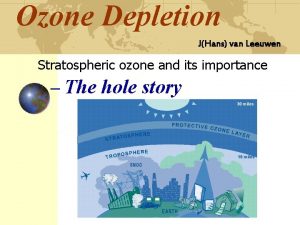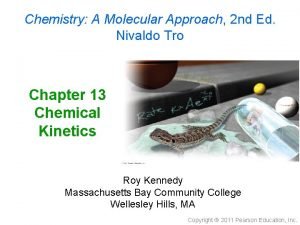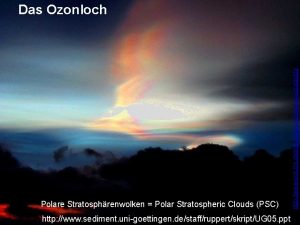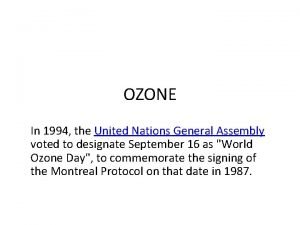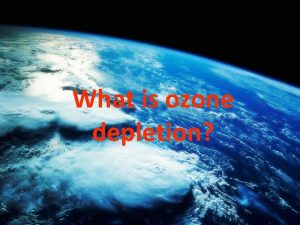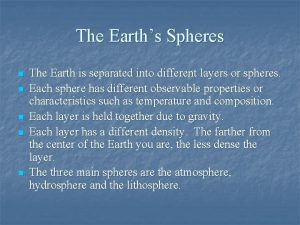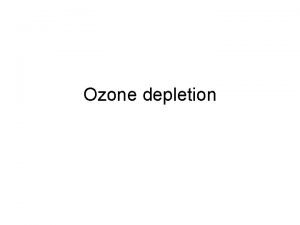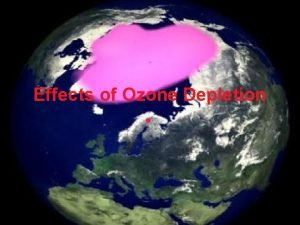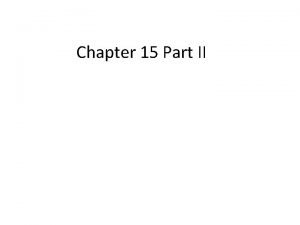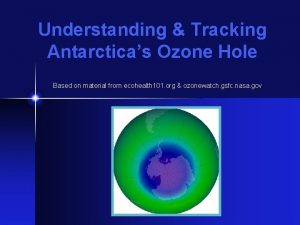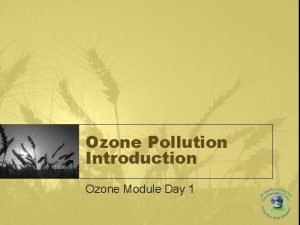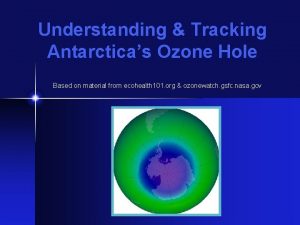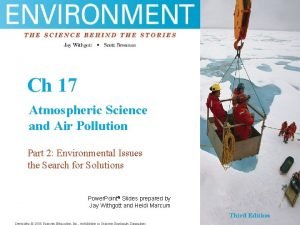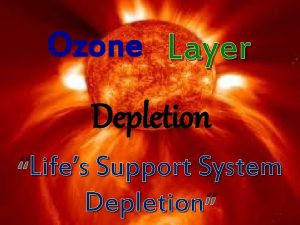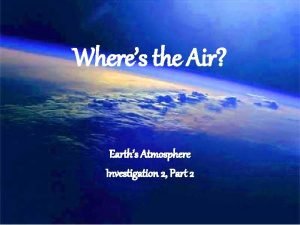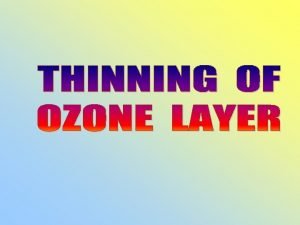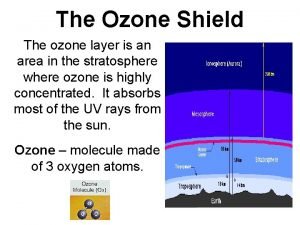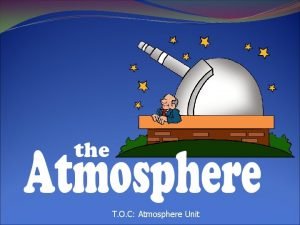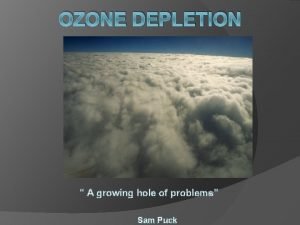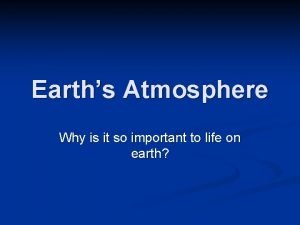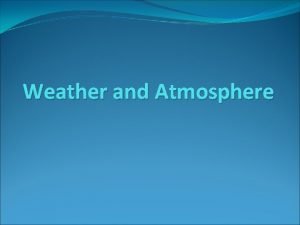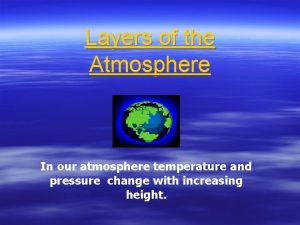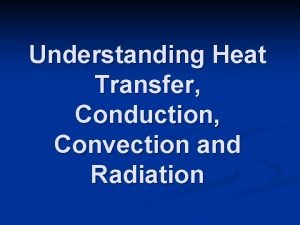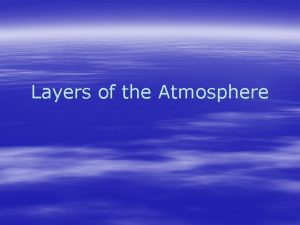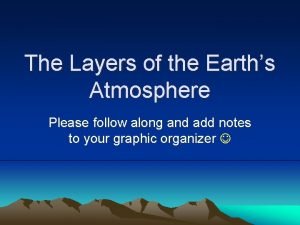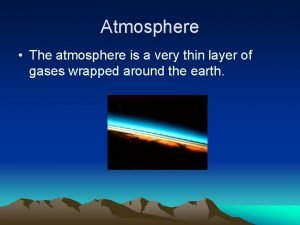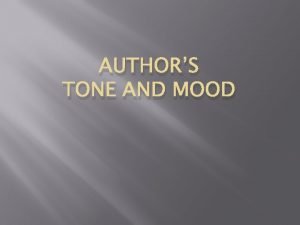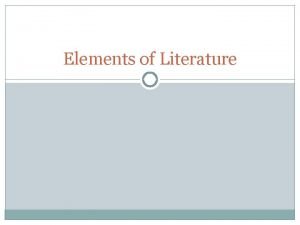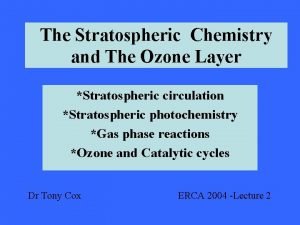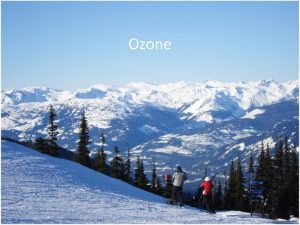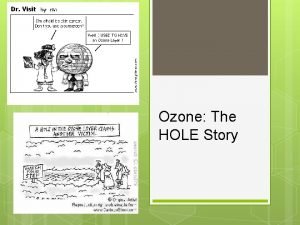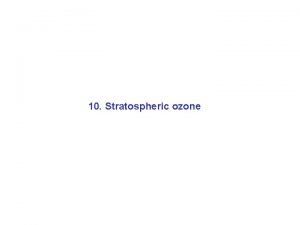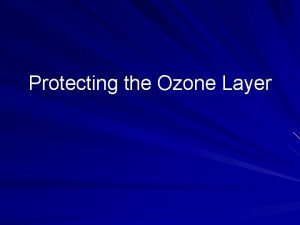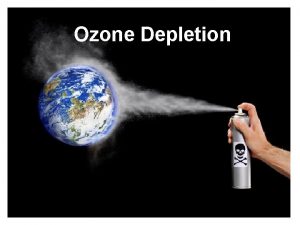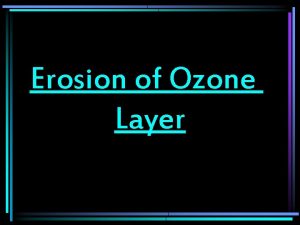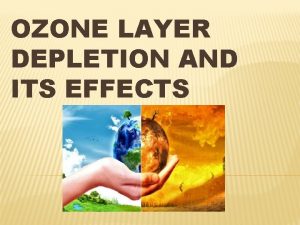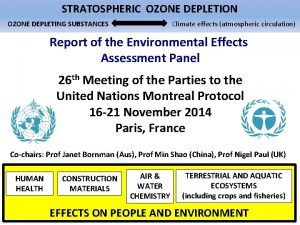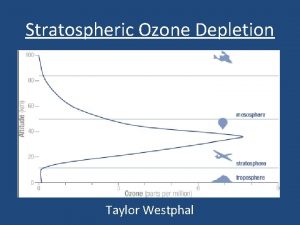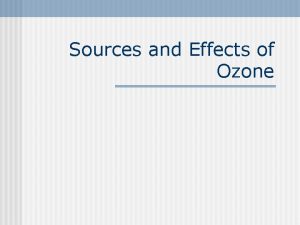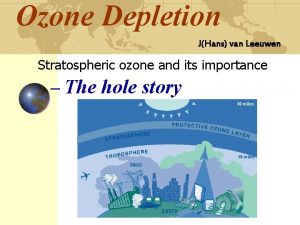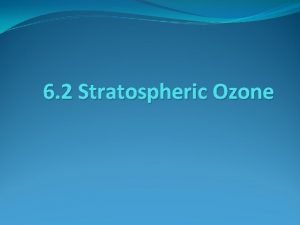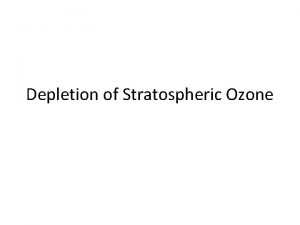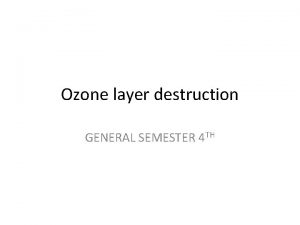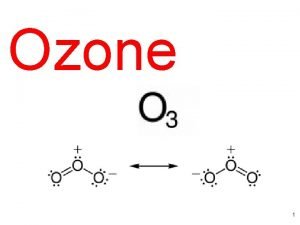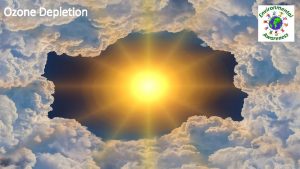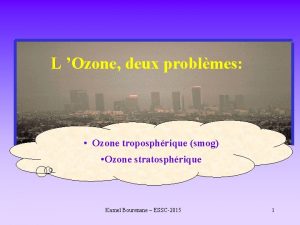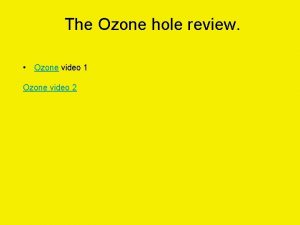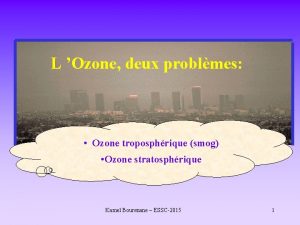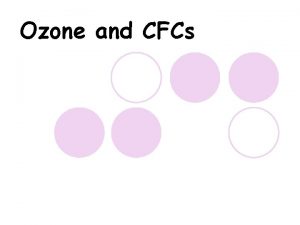Stratospheric Ozone Layer General considerations on the atmosphere




































- Slides: 36

Stratospheric Ozone Layer • General considerations on the atmosphere • Fundamentals of chemical kinetics • Chemistry of the stratospheric ozone layer

Chemical Composition of the Atmosphere Chemical composition of dry air Species Symbol Molar fraction Nitrogen N 2 78 % Oxygen O 2 21 % Argon Ar 0. 93 % CO 2 0. 04 % O 3 1 ppb to 10 ppm Methane CH 4 1. 8 ppm Nitrous oxide N 2 O 330 ppb Carbon dioxide Ozone 1 ppm = 10 -6 mole/mole of air; 1 ppb = 10 -9 mole/mole of air

Different Phases in the Atmosphere • Gases – Main gases (N 2, O 2) – Trace gases (pollutants) • Liquid water – Cloud and fog droplets – Raindrops • Solid water – Ice – Snow • Particles – Solid – Liquid

Radiative Transfer in the Atmosphere Radiative transfer in the atmosphere depends on the chemical composition of the atmosphere: • Oxygen and ozone absorb ultraviolet solar radiation in the stratosphere. • Greenhouse gases (water, carbon dioxide, methane, ozone, nitrous oxide…) absorb infrared terrestrial radiation in the troposphere. • These processes lead to increases in atmospheric temperature.

Ideal Gas Law Ideal gas law: PV=n. RT P (atm): Atmospheric pressure V (m 3): Volume of air T (K): Temperature R = 8. 31 J K-1 mole-1 = 8. 2 x 10 -5 atm m 3 K-1 mole-1: Ideal gas law constant n (moles): number of moles At P = 1 atm and T = 298 K (25 °C): n / V = 40. 9 moles / m 3 N = 6. 02 x 1023 molecules per mole ; 1 atm = 2. 46 x 1025 molec m-3

Unit Conversions 1 atm = 2. 46 x 1025 molecules m-3 = 40. 9 moles / m 3 At P = 1 atm: 1 ppb = 10 -9 atm = 2. 46 x 1010 molecules cm-3 (ppb: parts per billion) Conversion of mg/m 3 to ppb (MW is the molar weight of the chemical species in g/mole): 1 mg/m 3 = 1 O-6 / MW mole/m 3 = 1 O-6/ (40. 9 MW) atm = 103 / (40. 9 MW) ppb 1 ppb = (40. 9 MW) / 103 mg/m 3 For example, for ozone (MW = 48 g/mole): 1 ppb = 2 mg/m 3

Importance of Atmospheric Ozone • Radiative properties in the stratosphere: Problem of the destruction of the stratospheric ozone layer • Air pollutant in the lower atmosphere (troposphere): adverse health effects (pulmonary irritant) and damage to vegetation • Greenhouse gas • Ozone is a precursor of the hydroxyl radical, OH, which is the main oxidant in the atmosphere

Chemical Kinetics The order of a chemical reaction is defined by the number of chemical species that react: • Monomolecular reactions: – Photolytic dissociation (due to solar radiation) A + hn => B + C – Thermal dissociation (due to temperature) A => B + C • Bimolecular reactions: A + B => C + D • Termolecular reactions: A + B + M => C where M is O 2 or N 2

Chemical Kinetics The order of a chemical reaction is defined by the number of chemical species that react: • Unimolecular reactions: – Photolytic dissociation (due to solar radiation) O 3 + hn => O 2 + O(1 D) – Thermal dissociation (due to temperature) CH 3 C(O)O 2 NO 2 => CH 3 C(O)O 2 + NO 2 • Bimolecular reactions: NO + O 3 => NO 2 + O 2 • Termolecular reactions: NO + O 2 => 2 NO 2

Chemical Kinetics • Elementary reactions: a reaction that actually occurs (i. e. , not the representation of a group of reactions) • Principle of microreversibility: all elementary reactions are reversible. A + B => C + D => A + B Therefore: A + B <=> C + D • In most cases, one of the two kinetics prevails and one sees only an irreversible reaction.

Chemical Kinetics • The reaction rate “constant” characterizes the speed (kinetics) at which the reaction occurs. • The maximum kinetics is defined by the diffusion of molecules in the host medium (air, water…): it is 4. 3 x 10 -10 molec-1 cm 3 s-1 for a bimolecular reaction. • The reaction rate constant is actually a function of temperature.

Chemical Kinetics • Kinetic expression: k = AT TB exp( - Ea / (R T) ) T The reaction rate constant is defined by a pre-exponential factor (AT), the exponent (BT) of the temperature, and the activation energy (Ea); R is the ideal gas law constant (8. 3 J K-1 mole-1) and T is the temperature in K. If TB shows little variation with temperature compared to the exponential term, then the expression becomes the well-known Arrhenius equation: k = AT exp( - Ea / (R T) ) T The activation energy represents the energy needed for the reaction to take place. If this energy is very low, Ea << RT, i. e. Ea << 1 kcal, then k ~ AT TB T

Chemical Kinetics • Reversible reaction – If the rate constants of a direct reaction (kd) and its reverse reaction (kr) are of the same order of magnitude, one will see a reversible reaction: A + B => C + D => A + B kd kr A + B <=> C + D K = [C] [D] / [A] [B] = kd / kr where K is the equilibrium constant and [A] = molar or molecular concentration of species A

Chemical Kinetics • Reversible reaction – If the rate constants of a reaction and its reverse reaction are of the same order of magnitude, one will see a reversible reaction: NO 2 + NO 3 => N 2 O 5 => NO 2 + NO 3 kd kr NO 2 + NO 3 <=> N 2 O 5 K = [N 2 O 5] / [NO 2] [NO 3] = kd / kr

Chemical Kinetics • Rate of a chemical reaction The rate of a chemical reaction, vr, is defined as follows: a A + b B => g C + d D where a, b, g, and d are stoichiometric coefficients. where t is time. k

Chemical Kinetics • Rate of a chemical reaction: – In most cases, the coefficients are = 1 – The kinetics of a chemical reaction is then defined as follows: A + B => C + D k

Photochemical Reactions • Absorption of a photon from solar radiation by a molecule AB + hn(l) => AB* AB is a molecule (A and B are atoms or molecules) l is the wavelength of the absorbed radiation n is the frequency of the absorbed photon AB* is the excited state of AB • AB* being unstable, one can have: - Collision AB* + M => AB + M (where M is O 2 or N 2) - Dissociation reaction (the chemical bond is broken) AB* => A + B

Photochemical Reactions • Absorption of a photon from solar radiation by a molecule of oxygen O 2 + hn(l) => O 2* • O 2* being unstable, one can have: - Collision O 2* + M => O 2 + M (where M is O 2 or N 2) - Dissociation reaction (the O-O bond is broken) O 2* => O + O

Photochemical Reactions • Absorption of a photon from solar radiation by a molecule AB + hn(l) => AB* => A + B* The energy provided by the photons must be sufficient to break the bond linking the atoms of the molecule: Energy of one photon: hn = h c/l where h: Planck constant (6. 6 x 10 -34 m 2 kg s-1) ; n(l) : frequency of the photon; l: wavelength => Energy of one photon: hn = h c/l = 5 x 10 -19 J at 400 nm Energy of dissociation of the oxygen bond » 500 k. J/mole = 8. 3 x 10 -19 J/molec Therefore, visible light (l > 400 nm) does not have enough energy to break O 2; the photolysis of O 2 occurs for l < 242 nm

Atomic Oxygen • Different states of atomic oxygen: – Triplet state: O(3 P) – Singlet state: O(1 D) (more excited and unstable) O 2 + hn => O(3 P) + O(3 P) O 3 + hn => O 2 + O(1 D) • Stabilization of O(1 D) by collision with air molecules (O 2 and N 2) represented by M: O(1 D) + M => O(3 P) + M • Everywhereafter: O is used for O(3 P)

Photolytic Rate Constant • Rate constant for photolysis at wavelength l: where s. AB = absorptive properties of the molecule AB = effective crosssection of the absorption of radiation at the wavelength l (cm 2 molecule-1) Ij (l) = radiation received = actinic flux in photons cm-2 s-1 fj(l) = quantum yield = fraction of AB that participates in the reaction (molecule/photon)

Photolytic Rate Constant • J = 0 at night because only solar radiation is strong enough for photolysis to occur: fj(l) ≈ 0 for l > 730 nm (i. e. , in the infrared) Radiation received, Ij(l) depends on: - the solar zenith angle (angle of solar radiation with the vertical direction): function of hour, day, longitude, and latitude - atmospheric conditions (presence of aerosols, haze, clouds…) - altitude

Daytime Chemistry and Nighttime Chemistry • Daytime chemistry: – Photolysis => atoms and radicals => high reactivity of the atmosphere • Nighttime chemistry – No photolysis => few radicals => low reactivity of the atmosphere

Stratosphere and Troposphere • Stratosphere : – O 2 and O 3 absorb ultraviolet solar radiation (l < 400 nm) – Source of atomic oxygen to form O 3: O 2 + hn => O + O l < 242 nm • Troposphere – Solar radiation, which is effective for photolysis, is in the range: 290 nm < l < 730 nm – Source of atomic oxygen to form O 3: NO 2 + hn => NO + O 300 < l < 420 nm

Stratosphere and Troposphere Stratosphere Troposphere (< 15 km) Actinic flux as a function of wavelength at different altitudes in the atmosphere Source: De. More et al. , 1997

Oxidizing Power of the Atmosphere • Production of OH – Ozone photolysis leads to OH production: O 3 + hn (l < 310 nm) => O 2 + O(1 D) The excited oxygen atom becomes stable by reaction: O(1 D) + M => O(3 P) + M O(1 D) + H 2 O => 2 OH

Stratospheric Chemistry of Ozone • The stratospheric ozone layer plays a protective role against ultraviolet (UV) radiation. • The absorption of solar radiation leads to an increase of temperature in the stratosphere => stable conditions. • There is little mass transfer between the stratosphere and the troposphere because of this stable condition at the tropopause (the boundary between the stratosphere and the troposphere). • The tropopause can be defined by the change in the temperature vertical profile (heat transfer definition), by the change in the potential vorticity (dynamic definition) or by the change in the ozone concentration (chemical definition).

Stratospheric Chemistry of Ozone History • Sidney Chapman (1888 -1970) proposed in 1930 a cycle of reactions to explain the high concentrations of ozone in the stratosphere (Chapman, S. On ozone and atomic oxygen in the upper atmosphere ; Phil. Mag. S. 7, 10, 369 -383, 1930). • A comparison of his calculations with measurements showed a slight overestimation: the chemical mechanism was then improved in the 1950 s with reactions involving OH and HO 2 radicals.

Chapman Cycle • Oxygen photolysis (slow) O 2 + hn (l < 240 nm) => O + O k 1 • Ozone production (fast) O + O 2 + M => O 3 + M k 2 • Ozone photolysis (fast) O 3 + hn (240 < l < 320 nm) => O 2 + O(1 D) k 3 • Ozone destruction (slow) O + O 3 => 2 O 2 k 4

Ozonolysis • Ozone photolysis O 3 + hn (240 < l < 320 nm) => O 2 + O(1 D) • Ozone production O(1 D) + M => O O + O 2 + M => O 3 + M • Net chemical budget: zero (production = destruction) • Heat budget: solar radiation => heat (increase in temperature)

Chapman Cycle Characteristic time < 100 s O 2 hn slow O hn O 3 fast Characteristic time 1 day to several years depending on altitude and latitude

Stratospheric Chemistry of Ozone History • In the 1960 s, the increase in air traffic led to an increase in nitrogen oxide emissions (NOx) at high altitude; a chemical mechanism suggested a possible destruction of ozone due to a catalytic cycle including NO and NO 2 (P. Crutzen, National Center for Atmospheric Research (NCAR); H. Johnston, University of California at Berkeley) • In the 1970 s, the use of chemical compounds (chlorofluorocarbons, CFC), which were relatively inert in the troposphere, but were potentially photolyzed in the stratosphere, was suggested to lead to the destruction of the ozone layer via a catalytic reaction cycle (F. S. Rowland et M. Molina, University of California at Irvine)

Destruction of O 3 by Catalysis with CFC Chlorofluorocarbons (CFC) that do not contain a hydrogen atom, are not very reactive in the troposphere and are transported (slowly but surely) to the stratosphere where they can be photolyzed. Initiation: CFC + hn => Cl + radical (CFCl 2, CF 2 Cl…) Propagation: O 3 + Cl => O 2 + Cl. O + O(1 D) => O 2 + Cl Net budget: O 3 + O(1 D) Cl. Ox => 2 O 2 Termination: Cl + CH 4 => HCl + CH 3 (for example) Cl. O + NO 2 + M => Cl. NO 3 + M Cl. Ox

Stratospheric Chemistry of Ozone History • 1987: The Montreal protocol, which aims to reduce chlorofluorocarbon emissions, is signed by 24 countries and the European Union; it is amended in 1990, 1992, 1995, 1997, 1999, and 2016 (as of 2015, all 197 countries of the United Nations have ratified the protocol and its amendments) • 1995: Nobel Prize in Chemistry for Paul Crutzen (then at the Max Plack Institute, Germany), F. Sherwood Rowland (University of California at Irvine), and Mario Molina (then at MIT)

Global Emissions of Chlorocarbons

Global Concentrations of Chlorocarbons
 Stratospheric ozone depletion
Stratospheric ozone depletion Frequency factor units
Frequency factor units Stratospheric balloon
Stratospheric balloon Polar stratospheric clouds
Polar stratospheric clouds Polar stratospheric clouds
Polar stratospheric clouds Protection of ozone layer
Protection of ozone layer Protective ozone layer
Protective ozone layer Ozone layer
Ozone layer Ozone layer depletion effects on humans
Ozone layer depletion effects on humans Ozone layer levels
Ozone layer levels Causes of the ozone depletion
Causes of the ozone depletion Protective ozone layer
Protective ozone layer Where are the holes in the ozone layer located
Where are the holes in the ozone layer located Ozone layer depletion introduction
Ozone layer depletion introduction Copyright
Copyright Protective ozone layer
Protective ozone layer Wheres the ozone layer
Wheres the ozone layer Ozone layer made up of
Ozone layer made up of Ozone layer definition
Ozone layer definition The ozone layer protects us from
The ozone layer protects us from Ozone layer simple definition
Ozone layer simple definition Durite
Durite Atmosphere definition science
Atmosphere definition science Layers of the atmosphere
Layers of the atmosphere Troposphere characteristics
Troposphere characteristics Outermost layer of the atmosphere
Outermost layer of the atmosphere Hottest layer of atmosphere
Hottest layer of atmosphere Why do scientists divide the atmosphere into layers
Why do scientists divide the atmosphere into layers Thermosphere pictures
Thermosphere pictures A very thin layer
A very thin layer Amused tone or mood
Amused tone or mood General atmosphere of a narrative
General atmosphere of a narrative Presentation layer functions
Presentation layer functions Layer 2 e layer 3
Layer 2 e layer 3 Pigmented layer and neural layer
Pigmented layer and neural layer Secure socket layer and transport layer security
Secure socket layer and transport layer security Layer-by-layer assembly
Layer-by-layer assembly
